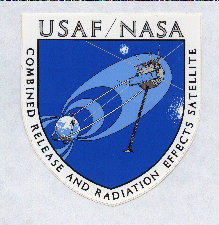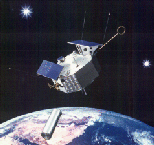CRRES
The Combined Release and Radiation Effects Satellite
The mission The CRRES spacecraft was launched on 25th July 1990 to study the near-Earth space environment and the effects of the Earth's radiation environment on microelectronic components.
It operated in a highly elliptical geosynchronous transfer orbit with a perigee of 305 km and an apogee of 35,768 km and an inclination of 18 degrees. The orbital period was 9 hours and 52 minutes and the initial apogee was at a magnetic local time of 08:00 MLT. The satellite thus swept through the heart of the radiation belts on average approximately 5 times per day, providing gopod coverage of this important region.
The CRRES spacecraft was launched on 25th July 1990 to study the near-Earth space environment and the effects of the Earth's radiation environment on microelectronic components.
It operated in a highly elliptical geosynchronous transfer orbit with a perigee of 305 km and an apogee of 35,768 km and an inclination of 18 degrees. The orbital period was 9 hours and 52 minutes and the initial apogee was at a magnetic local time of 08:00 MLT. The satellite thus swept through the heart of the radiation belts on average approximately 5 times per day, providing gopod coverage of this important region.
The three primary mission objectives were:
- Performance of active chemical release experiments in the ionsphere and magnetosphere.
- Studies of the natural radiation environment and studies of the effects of this radiation environment upon microelectronic components as CRRES traveled through inner and outer radiation belts of the earth.
- Low altitude studies of ionspheric irregularities which are performed in the ionsphere near the orbit perigee.
 The Low
Energy Plasma Analyser (LEPA) instrument consisted of two electrostatic
analysers with microchannel plate detectors, each with a field of view
of 120 degrees by 5 degrees, one measuring electrons, the other ions in
the energy range 100 eV < E < 30 keV. The analysers were mounted
on the spacecraft with the 120 degree range covering angles from 30 degrees
to 150 degrees with respect to the spacecraft spin axis, the total range
being divided intop 15 zones 8 degrees wide. The energy range was swept
through the complete range 64 times per spin, synchronised to the spin
period of 30 s. The instrument detected the complete pitch angle range
from 0 degrees to 180 degrees every 30 s with a resolution of 5.625 x 8
degrees at all energies in the range 100 eV < E < 30 keV.
The Low
Energy Plasma Analyser (LEPA) instrument consisted of two electrostatic
analysers with microchannel plate detectors, each with a field of view
of 120 degrees by 5 degrees, one measuring electrons, the other ions in
the energy range 100 eV < E < 30 keV. The analysers were mounted
on the spacecraft with the 120 degree range covering angles from 30 degrees
to 150 degrees with respect to the spacecraft spin axis, the total range
being divided intop 15 zones 8 degrees wide. The energy range was swept
through the complete range 64 times per spin, synchronised to the spin
period of 30 s. The instrument detected the complete pitch angle range
from 0 degrees to 180 degrees every 30 s with a resolution of 5.625 x 8
degrees at all energies in the range 100 eV < E < 30 keV.
The detailed pitch-angle distributions provided by the LEPA instrument have been used (and continue to be used) succesfully in a number of investigations including:-
- the role of wave-particle interactions in the production of the diffuse aurora.
- studies of field-aligned electron distributions in the inner magnetosphere.